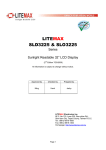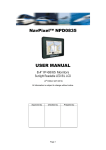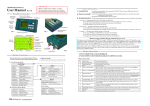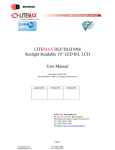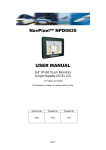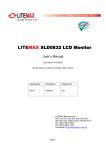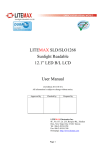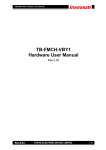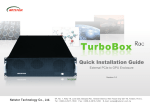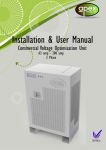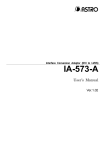Download Litemax Cover
Transcript
LITEMAX SLD/SLO0625 Sunlight Readable 6.5” LED B/L LCD User Manual (1st Edition 2011/8/15 ) All information is subject to change without notice. Approved by Checked by Prepared by LITEMAX Electronics Inc. 8F., No.137, Ln. 235, Baoqiao Rd., Xindian Dist., New Taipei City 23145, Taiwan Tel : 886-2-8919-1858 Fax: 886-2-8919-1300 Homepage: http://www.litemax.com/ Page 1 RECORD OF REVISION Version and Date Aug,15,2011 Page Old Description all New Description Preliminary Release Page 2 Remark Contents RECORD OF REVISION........................................................................................................................ 2 Contents................................................................................................................................................ 3 1.0 GENERAL DESCRIPTION .............................................................................................................. 4 1.1 FEATURES ............................................................................................................................... 4 1.2 GENERAL SPECIFICATIONS................................................................................................... 4 1.3 ABSOLUTE MAXIMUM RATINGS ............................................................................................ 5 2.0 Electrical characteristics ............................................................................................................... 6 3.0 SIGNAL Characteristic ................................................................................................................... 7 4.0 TIMING Characteristics................................................................................................................ 11 5.0 CONNECTOR and PIN ASSIGNMENT ......................................................................................... 13 6.0 OPTICAL SPECIFICATION........................................................................................................... 14 7.0 LED Backlight Unit Driving.......................................................................................................... 16 8.0 OSD Manual .................................................................................................................................. 17 9.0 MECHANICAL DRAWING............................................................................................................. 23 10.0 PRECAUTIONS ........................................................................................................................... 25 Page 3 1.0 GENERAL DESCRIPTION SLD/SLO0625 is a TFT LCD monitor, built-in 1000 nits high brightness for sunlight readable display. Features wide operating temperature, high brightness, AOT optical bonding, touch screen capable, and customized mechanical design; fulfill the demand for extreme environments. The high level of brightness together with LED backlight technology, the monitor brings remarkable display quality.Perfectly suitable for kiosk, ATM, POS, military, transportation, and outdoor industrial application. 1.1 FEATURES Sunlight Readable LED Backlight High Shock & Vibration Resistance Low Power Consumption Wide Temperature. Range High Uniformity Low EMI Noise Wide Dimming Life Expectancy 1.2 GENERAL SPECIFICATIONS Model No. SLD0625 Description Backlight Display Area (mm) Brightness Resolution Contrast Ratio Pixel Pitch (mm) Viewing Angle Display Colors Response Time (Typical) Power Input Power Consumption Dimensions (mm) Weight (Net) 6.5" TFT LCD monitor, LED Backlight 1000 nits, VGA LED Backlight 132.48 x 99.36 mm 1,000 cd/m2 640 x480 (VGA) 600 : 1 0.207(H) x 0.207(V) 160°(H), 140°(V) 16.2M colors 25ms (Typical) DC 12V 5W 172.2x101x33.5mm 172.2x165.2x33.5mm 0.38Kg 0.42Kg SLO0625 Page 4 1.3 ABSOLUTE MAXIMUM RATINGS TFT LCD Module ABSOLUTE RATINGS OF ENVIRONMENT Page 5 2.0 Electrical characteristics TFT LCD Module Power Specification Input power specifications are as following: Note 1: Measurement Condition Page 6 3.0 SIGNAL Characteristic Input Signals should be low or Hi-Z state when VDD is off. LVDS signal Page 7 Pixel Format Image Following picture shows the relationship between the input signal and LCD pixel format. The Input Date Format Page 8 Page 9 TFT-LCD Interface Signal Description LVDS is a differential signal technology for high‐speed data transfer LCD interface. LVDS Transmitter shall be THC63LVDM83A (THINE) or equivalent. Page 10 4.0 TIMING Characteristics DE mode only Input Timing diagram Page 11 Power ON/OFF Sequence VDD power, LCD interface signals and backlight on/off sequence are shown in the following chart. Signals from any system shall be Hi-Z state or low level when VDD is off. Page 12 5.0 CONNECTOR and PIN ASSIGNMENT TFT LCD Connector & Pin Assignment Backlight Connector & Pin Assignment Page 13 6.0 OPTICAL SPECIFICATION Item Symbol Red Color Green Condition Data Unit Rx 0.599 - Ry 0.379 - Gx 0.325 - Gy 0.605 - Bx θx=0 0.145 - By θy=0 0.114 - Wx BM-7 0.311 - Wy 0.349 - Center Luminance of White Lc 1000±10% cd/㎡ Average La 950 cd/㎡ Uniform Lu 75±5 % Contrast Ratio CR 600 - Color Saturation NTSC 55 % chromaticity Blue White Viewing Angle Horizontal Vertical θx=0 θy=0 Klein K-10 θy+ Test Mode: (1) (2) (3) Test Mode: (1) (4) 80 θx+ θx- Note CR≧10 80 70 70 θy- Test Mode: (1) Definition of Viewing Angle(θx,θy): Page 14 Deg Test Mode: (1) (3) (2) Definition of Test Point: A B C 1 2 3 Active Area (3)BM-7 Measurement Setup: (4)Klein K-10 Measurement Setup: Page 15 7.0 LED Backlight Unit Driving 1. Parameter guideline for LED driving Following characteristics are measured under stable condition at 25 degree C (room temperature). LED Backlight Unit Interface Signal Description Page 16 8.0 OSD Manual Here are some instructions for you to use the OSD (On Screen Display). By pressing the “menu”, you will see the below picture. Timing shows resolution, H-frequency ,and V-frequency of the panel.Version shows the firmware control version. This 2 information is not changeable by user. OSD Brightness: press ’’right’’ key press “menu” once, you can go into adjust the brightness. Press “left” you can dim down the brightness to “0”, while press “right” you can increase the brightness to “100”. Contrast: Press “menu” and “right” you can adjust the contrast from “0” to “100” by pressing the “left” and “right”. Exit: You can exit this sub menu back to normal screen. Page 17 Auto Color: by press this “Auto Color” option, you can get the optimal color performance. SRGB: Windows standard color setting. Page 18 Color Tempture: You can have 3 options in this selection. Color Tempture User Color Tempture_6500K Color Tempture_93OOK “user mode”, “6500K” (Warm color scheme), “9300K (Cold color scheme). Def ault is “user”, and inside all “R”, “G”, and “B” are set “100” Exit: back to the normal screen. Go into the “Image” page, you can see below picture. Page 19 Auto just: Pressing this option, the AD5621 will adjust the optimal frequency of horizontal and vertical. You will see “Auto tune….” On the screen for around 3 seconds. Clock: If you are not satisfied about the Autotune result, you can adjust manually by “Clock”. The screen will be “wider” if you adjust this function. Phase: If you see “double image” on characters, you can adjust “Phase” to make it perfect image. HPos: You can shift the screen horizontally by this function. Vpos: You can shift the screen vertically by this function. Exit: Back to normal screen. On the “Tools” sub menu, you will see 5 icons. Page 20 OSD Control: Select this option, you will see 4 more options: Osd_time: You can selection the time of OSD from 2 sec. to 16 sec. Osd_HPos: You can move the OSD horizontally over the screen. Osd_VPos: You can move the OSD Vertically over the screen. Exit: back to main menu. Page 21 D Factory_Reset: By pressing this, the screen will be back to the factory setting on very beginning and lost all the personal settings. Sharpness: You can make the characters looks sharper. Dos_mode/Gxf_mode: Some old programs running over 640x400 and 720x400 (DOS Mode and graphics mode), you need to select this option manually. Exit Factory Burn-in mode: While your VGA cable is connected on the monitor, press “Menu” and Left <” simultaneously, you will see “BURN IN MODE” on the center of the screen for 3 sec. Then unplug the VGA cable, the screen will show Red, Green, Blue, White, and Black in sequence automatically. You can plug in the VGA signal cable, and re-plug the power connector to exit the burn-in mode. OSD Lock Function: It is possible to lock all the OSD buttons to prevent unauthorized changes to occur by pressing “Menu” and “right >” buttons simultaneously. the center of the screen for 3 seconds. You will see the “lock” icon below on If any button is pushed after the lock function is initiated, the below icon will appear on the screen.' To release the OSD lock, press “Menu” and “Right >”. the screen for 3 seconds. The below icon will appear on the center of Now all OSD keys are active again. Page 22 9.0 MECHANICAL DRAWING SLD0625 Page 23 SLO0625 Page 24 10.0 PRECAUTIONS HANDLING PRECAUTIONS (1) The module should be assembled into the system firmly by using every mounting hole. Be careful not to twist or bend the module. (2) While assembling or installing modules, it can only be in the clean area. The dust and oil may cause electrical short or damage the polarizer. (3) Use fingerstalls or soft gloves in order to keep display clean during the incoming inspection and assembly process. (4) Do not press or scratch the surface harder than a HB pencil lead on the panel because the polarizer is very soft and easily scratched. (5) If the surface of the polarizer is dirty, please clean it by some absorbent cotton or soft cloth. Do not use Ketone type materials (ex. Acetone), Ethyl alcohol, Toluene, Ethyl acid or Methyl chloride. It might permanently damage the polarizer due to chemical reaction. (6) Wipe off water droplets or oil immediately. Staining and discoloration may occur if they left on panel for a long time. (7) If the liquid crystal material leaks from the panel, it should be kept away from the eyes or mouth. In case of contacting with hands, legs or clothes, it must be washed away thoroughly with soap. (8) Protect the module from static electricity, it may cause damage to the C-MOS Gate Array IC. (9) Do not disassemble the module. (10) Do not pull or fold the lamp wire. (11) Pins of I/F connector should not be touched directly with bare hands. STORAGE PRECAUTIONS (1) High temperature or humidity may reduce the performance of module. Please store LCD module within the specified storage conditions. (2) It is dangerous that moisture come into or contacted the LCD module, because the moisture may damage LCD module when it is operating. (3) It may reduce the display quality if the ambient temperature is lower than 10 ºC. For example, the response time will become slowly, and the starting voltage of lamp will be higher than the room temperature. OPERATION PRECAUTIONS (1) Do not pull the I/F connector in or out while the module is operating. (2) Always follow the correct power on/off sequence when LCD module is connecting and operating. This can prevent the CMOS LSI chips from damage during latch-up. Page 25


























